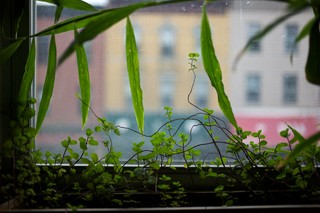The best herbs to grow in low light

In order to thrive, plants need sunlight, water, and nutrients. These three components come together and facilitate the growth processes within plants. This can present challenges to some homeowners who want to grow plants indoors when there is limited sunlight exposure. Thankfully, there are some plants - herbs included - that have adapted to grow well in low light conditions as long as their other needs are fulfilled.
If you are interested in growing herbs but have low light conditions inside your home it’s beneficial to understand why sunlight is important to plants, how some plants have adapted to low light conditions, what herbs can be grown in low light, and considerations to keep in mind when growing plants where the lighting isn’t optimal.
Importance of sunlight
Either directly or indirectly, all living organisms on the planet rely upon the light given off by the sun as their primary source of energy.
Plants, alga, and certain types of bacteria use cellular “solar panels” to collect the energy from sunlight. Once stored, this energy is used to propel photosynthesis, a chemical process that breaks down water and carbon dioxide to produce glucose and oxygen. The glucose is usable by plants as a food source and the oxygen is given off to the atmosphere.
Higher organisms, on the other hand, don’t absorb energy from sunlight directly but instead consume green plants or other photosynthesis-capable organisms; in turn, their energy is garnered from food sources that have already harnessed the sun’s energy.
An amazing aspect of plants is their ability to adapt to their growing conditions, allowing them to thrive in adversity. While all plants need the sun’s energy for photosynthesis, some plants grow in lower light conditions and have adapted to optimize what little sunlight they receive.

If we ever enter perma-winter we’ll still have mint! Mint is one of the easiest herbs to grow and can thrive in low light conditions. Image: bfishadow
Why can some herbs grow with less light?
In certain conditions - such as in the understory of thick overhead foliage growth, or close to the poles of the earth - plants have little exposure to direct sunlight. Genetic adaptations have naturally occurred within these plants to allow them to photosynthesize and survive.
Under chronic low light conditions, the amount of photosynthesis occurring and the glucose produced highly depends upon how efficiently light energy is captured by the leaves.[1] To increase this efficiency, light-starved leaves have adapted so they are darker green in color, thinner, and larger.
- Leaves are darker green in coloration as they have larger chloroplasts (the cells where photosynthesis occurs) and contain more chlorophyll, allowing them to capture light more efficiently.
- Leaves are thinner in shade plants than sun plants because of changes in their cellular makeup. Compared to full sun leaves, the shade leaves contain fewer layers of columnar palisade cells,[1:1] the chloroplasts are more evenly spread out instead of bunched up, and the mesophyll layer is thinner for better carbon dioxide exchange within the pore space surrounding the spongy portions of parenchyma cells – all of which result in thinner leaves.
- Leaves are larger in shade leaves to provide more surface area to absorb light energy. More surface area equates to more light energy collected, even in low light.

The enthusiast's guide to herbs
We’re proud to present our new e-book, The Enthusiast’s Guide to Herbs! Learn everything you need to know about growing and caring for herbs indoors, including in-depth info cards for the 35 most commonly grown herbs.
Click the link below to find out more!
Best herbs to grow indoors in low light
Sometimes there just isn’t any way around low light conditions indoors. This doesn’t have to deter you from growing herbs inside; it only means you have to think a little outside the box and tailor what you grow to your available conditions.
The herbs listed below are known to grow well when planted outdoors in shady spots of the yard. This natural predisposition for shade makes them more apt to do well when grown inside under low light conditions.
-
Mint is a great option for container gardening indoors because of it’s easy to grow, albeit prolific, nature. Growing it in containers keeps it from taking over all of your outdoor gardening space and provides you with a plentiful supply of fresh herbs that can be used in both culinary and medicinal facets. The two most commonly grown types of mint are peppermint and spearmint.
-
Parsley is multi-functional as both an ornamental herb and for its practical purposes in recipes. Curly leaf parsley is less flavorful and primarily used as decoration; Italian, or flat-leaf, parsley is known for its stronger, somewhat sweet flavor. As an added benefit it is rich in vitamin A, vitamin C, and iron.
-
Cilantro is related to parsley and is useful for flavoring dishes in place of salt, cutting down sodium intake for those who need to monitor their sodium intake for heart health. When left to go to seed, you can then add coriander to your pantry as well.
-
Thyme bears heady aromatic leaves on a low-growing evergreen plant. Its flavor depends on the variety chosen and is commonly used to add a subtle, savory note to meat dishes, soups, and stews. The three commonly grown varieties are French, lemon, and caraway thyme.
-
Chives are grown for both their beautiful flowers and delicious leaves. Onion and garlic chives are the two most commonly grown and used in a similar fashion depending on the flavor desired in a recipe or dish.
-
Lemon balm isn’t as popular as other herbs but it makes a fantastic addition to your indoor herb garden, especially in low light settings. A member of the mint family, lemon balm has a delicious lemony and taste. It is most commonly used in teas, in potpourri, or as a natural insect repellent.
**Consider Microgreens instead - **A microgreen kit, like the one from Hamama, can be a great alternative to growing tradition herbs indoors. You can read more about microgreens, they’re great nutritional value, and how to grow them in our complete microgreen guide.
Special considerations for low light conditions
When growing herbs under low light conditions it will be necessary to tweak your growing or management practices slightly to accommodate the environment. Plants grow differently in the lower light; caring for them the same way as herbs grown in full-sun will lead to problems and poor growth.
- Reduce the amount of water applied to the herbs and the frequency in which you water containers. Less sunlight means less photosynthesis is occurring within the leaves, in turn, plants need less water for their day to day functions. Less sunlight also equates to less water lost to evaporation. Due to both of these factors, the growing media doesn’t dry out as quickly and increases the susceptibility of root rot.
- When planting your herbs in containers opt for a growing media that dries out more quickly. Look for potting mixes that contain higher levels of perlite, sand, or vermiculite to increase the drainage in the pots or choose to make your own potting mix to meet the exact specifications you’re looking for.
- Opt for shallow containers with plenty of drainage holes to grow your herbs in. The reduced depth of the pot encourages the growing media to dry more quickly, keeping the media from staying too wet between waterings.
- Maintain good air flow between plants and around containers. Adequate air movement will help to dry out growing media more quickly - compensating for the lack of evaporation normally occurring in higher light conditions- reducing the incidence of root rot and other fungal or bacterial diseases. It will also cut down on insect problems.
Conclusion
Even though sunlight is a critical component of plant growth, there are some herbs that grow well in lower light conditions. Adaptations in their leaf structure allow them to complete the breakdown of carbon dioxide when little light is present, circumventing the need to be exposed to a lot of sunlight. These adaptations are useful in many situations, including the case of homeowners who want to grow herbs indoors but their home has limited direct sunlight.

Join our email club—get printable info cards free!
Sign up to receive our newsletter and get access to 10 printable plant info cards from our e-book for free. Also receive:
- $4 discount code for our Guide to Herbs e-book
- Semi-weekly plant inspiration & bite-size tips and tricks
Ruban A. V. (2009). Plants in light. Communicative & Integrative Biology, 2(1), 50–55. Retrieved from https://www.ncbi.nlm.nih.gov/pmc/articles/PMC2649303/ ↩︎ ↩︎
